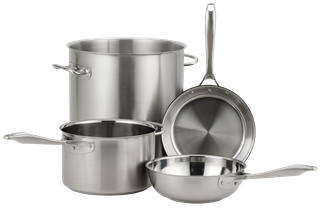Stainless Steel Basics

Grades
There are over 150 different grades of stainless steel, four of which have proven to be the best suited for foodservice equipment. But because the prices of raw materials (especially nickel) have risen dramatically in recent years, buyers today must be especially careful of equipment manufacturers that carelessly “skimp” on essential ingredients. Let’s look at the formulations of the four most common grades.
| Stainless Steel Grade | Description | Commonly Used For |
|---|---|---|
| 304 | Often referred to as “18-8,” 304 stainless steel consists mainly of iron plus 18% chromium and 8% nickel. This formula provides a well-balanced combination of strength plus superior resistance to corrosion and staining caused by acidic foods. Its higher nickel content also allows for more workability to prevent cracking when making products such as stock pots. 304 stainless steel is specified for more than half of all foodservice products. | Cookware, steam table pans, chafers, serving trays, utensils, etc. |
| 301 | This is “17-6” stainless steel, made of iron plus 17% chromium and 6% nickel. Since 301 has less nickel, it is stronger but more likely to crack if formed too dramatically. | Sinks, pots and pans, food processing equipment |
| 201 | 201 stainless steel consists of iron plus 17% chromium and 4.5% nickel. This formula has 6.5% manganese to partially substitute for the lower nickel content. This substitution is cheaper to produce but results in slightly lower corrosion resistance. | Counters, oven parts, pan covers, tray slides |
| 430 | This grade of stainless steel contains 17% chromium and little or no nickel. The lack of nickel makes this formula difficult to form and more susceptible to corrosion than 300- series stainless steel. | Cabinet panels such as for refrigerators and buffet lines, carts, flatware |
Stainless steel is made up of several elements, and each of these elements serves a different purpose, like ingredients in a recipe. Similar to restaurants, some stainless steel manufacturers use only the finest ingredients, while some skimp in order to cut their costs. These low-quality manufacturers depend on customers not knowing the difference — until it’s too late. But if you know the ingredients in stainless steel, you can invest in high-quality products that will provide you with maximum performance and durability.
Basic Ingredients in Stainless Steel

- Iron: Very strong, very corrosive. Makes up 70-75% of stainless steel.
- Chromium: Highly noncorrosive. To be called stainless, steel must have a minimum of 11% chromium.
- Nickel: Soft, some corrosion resistance. Makes metal easier to form and adds luster.
- Manganese: Binds steel alloys together, reducing brittleness and cracking.
- Copper: Soft, conducts heat and electricity. Can replace nickel to make metal easier to form.
- Carbon: Strong, corrosive. Added for strength.





